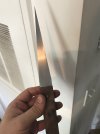Has anyone else followed this DVD? I am trying to work out a detail about the wedge angle. I might just be chasing my own tail, though.
The plans he gives, the difference between the bed and breast angle is identical to the wedge angle. However, the iron is tapered; Lie-Nielsen sells blade blanks that I imagine are supposed to go with this DVD and they go from 1/8 to 1/16 over 8" which is approximately 1/2 a degree.
So I would imagine the wedge angle would actually have to be about 1/2 degree larger than the bed/breast angle difference, but in the DVD it is not. If I am doing my math right this is going to result in about a 1/32" gap between the wedge and body at the top (not on the left or right side of the wedge, but front to back.)
I realize this is a pretty small amount and could be tweaked out during final wedge/iron fitting but that seems out of place in a DVD where he's talking about sawing the escapement at an angle specified down to quarters of a degree. So I feel like I am missing something.
I have done the math on how much the leaning iron design affects the required wedge angle vs the bed/breast angle layout lines on the flat sides of the body and it seems insignificant.
I vaguely remember someone saying that a small gap in that area is OK because the wedge really only needs to fit left-to-right at the top of the plane, and the front-to-back contact should be near the mouth. But I can't remember if it's in this DVD or the Tod Herrli one or some random youtube video.
Is there something I am missing or forgetting here?
The plans he gives, the difference between the bed and breast angle is identical to the wedge angle. However, the iron is tapered; Lie-Nielsen sells blade blanks that I imagine are supposed to go with this DVD and they go from 1/8 to 1/16 over 8" which is approximately 1/2 a degree.
So I would imagine the wedge angle would actually have to be about 1/2 degree larger than the bed/breast angle difference, but in the DVD it is not. If I am doing my math right this is going to result in about a 1/32" gap between the wedge and body at the top (not on the left or right side of the wedge, but front to back.)
I realize this is a pretty small amount and could be tweaked out during final wedge/iron fitting but that seems out of place in a DVD where he's talking about sawing the escapement at an angle specified down to quarters of a degree. So I feel like I am missing something.
I have done the math on how much the leaning iron design affects the required wedge angle vs the bed/breast angle layout lines on the flat sides of the body and it seems insignificant.
I vaguely remember someone saying that a small gap in that area is OK because the wedge really only needs to fit left-to-right at the top of the plane, and the front-to-back contact should be near the mouth. But I can't remember if it's in this DVD or the Tod Herrli one or some random youtube video.
Is there something I am missing or forgetting here?

